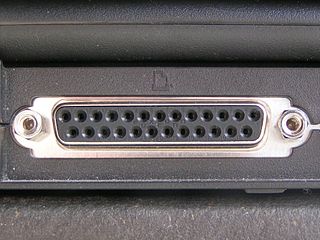AppleTalk is a discontinued proprietary suite of networking protocols developed by Apple Inc. for their Macintosh computers. AppleTalk includes a number of features that allow local area networks to be connected with no prior setup or the need for a centralized router or server of any sort. Connected AppleTalk-equipped systems automatically assign addresses, update the distributed namespace, and configure any required inter-networking routing.

The LaserWriter is a laser printer with built-in PostScript interpreter sold by Apple Computer, Inc. from 1985 to 1988. It was one of the first laser printers available to the mass market. In combination with WYSIWYG publishing software like PageMaker, that operated on top of the graphical user interface of Macintosh computers, the LaserWriter was a key component at the beginning of the desktop publishing revolution.

LocalTalk is a particular implementation of the physical layer of the AppleTalk networking system from Apple Computer.

The Macintosh Plus computer is the third model in the Macintosh line, introduced on January 16, 1986, two years after the original Macintosh and a little more than a year after the Macintosh 512K, with a price tag of US$2599. As an evolutionary improvement over the 512K, it shipped with 1 MB of RAM standard, expandable to 4 MB, and an external SCSI peripheral bus, among smaller improvements. It originally had the same generally beige-colored case as the original Macintosh, but in 1987, the case color was changed to the long-lived, warm gray "Platinum" color. It is the earliest Macintosh model able to run System 7 OS.

The ImageWriter is a product line of dot matrix printers formerly manufactured by Apple Computer, Inc., and designed then to be compatible with their entire line of computers. There were three different models introduced over time, which were popular mostly among Apple II and Macintosh owners.

The Macintosh IIsi is a personal computer designed, manufactured and sold by Apple Computer, Inc. from October 1990 to March 1993. Introduced as a lower-cost alternative to the other Macintosh II family of desktop models, it was popular for home use, as it offered more expandability and performance than the Macintosh LC, which was introduced at the same time. Like the LC, it has built-in sound support, as well as support for color displays, with a maximum screen resolution of 640×480 in eight-bit color.
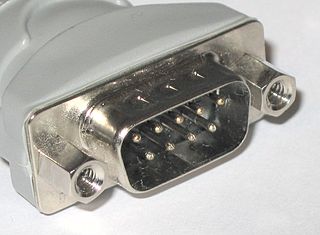
The D-subminiature or D-sub is a common type of electrical connector. They are named for their characteristic D-shaped metal shield. When they were introduced, D-subs were among the smallest connectors used on computer systems.

The Macintosh 128K, originally released as the Apple Macintosh, is the original Apple Macintosh personal computer. Its beige case consisted of a 9 in (23 cm) CRT monitor and came with a keyboard and mouse. A handle built into the top of the case made it easier for the computer to be lifted and carried. It had an initial selling price of $2,495. The Macintosh was introduced by the now-famous $370,000 television commercial by Ridley Scott, "1984", that aired on CBS during the third quarter of Super Bowl XVIII on January 22, 1984. Sales of the Macintosh were strong from its initial release on January 24, 1984, and reached 70,000 units on May 3, 1984. Upon the release of its successor, the Macintosh 512K, it was rebranded as the Macintosh 128K. This computer did not have a model number.

The Macintosh 512K is a personal computer that was designed, manufactured and sold by Apple Computer, inc. from September 1984 to April 1986. It is the first update to the original Macintosh 128K. It was virtually identical to the previous Macintosh, differing primarily in the amount of built-in random-access memory. The increased memory turned the Macintosh into a more business-capable computer and gained the ability to run more software.
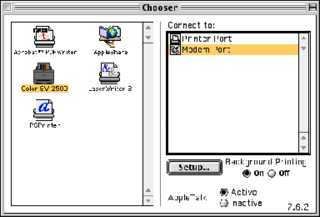
The Chooser is an application program for Macintosh systems using the classic Mac OS. The Chooser started out as a desk accessory and became a standalone application program as of System 7. The Chooser allowed users to connect to AppleShare file servers, enable or disable the network access, and select which printer to use.
The General Computer Corporation (GCC) is a printer company formed in 1981 by Doug Macrae, John Tylko, and Kevin Curran. The company began as a video game company. They later changed to make computer peripherals.

A legacy port is a computer port or connector that is considered by some to be fully or partially superseded. The replacement ports usually provide most of the functionality of the legacy ports with higher speeds, more compact design, or plug and play and hot swap capabilities for greater ease of use. Modern PC motherboards use separate Super I/O controllers to provide legacy ports since current chipsets do not offer direct support for them. A category of computers called legacy-free PCs omits these ports, typically retaining only USB for external expansion.

The PowerBook 3400c is a laptop computer in the PowerBook line manufactured by Apple Computer, Inc. from February to November 1997. It was, briefly, the swiftest laptop in the world. Using the PowerPC 603e processor running at speeds of up to 240 MHz, this PowerBook was the first to feature a PCI architecture, EDO memory, and a 64-bit wide, 40 MHz internal bus. It was also the first PowerBook to feature a PC card slot capable of being used as a zoomed video port. Like all Apple laptops since the PowerBook 500 series, it featured a built-in trackpad as the pointing device.

The Macintosh Quadra 605 is a personal computer designed, manufactured, and sold by Apple Computer, Inc. from October 1993 to July 1996. The model names reflect a decision made at Apple in 1993 to follow an emerging industry trend of naming product families for their target customers – Quadra for business, LC for education, and Performa for home. Accordingly, the Performa 475 and 476 was sold in department stores and electronics stores such as Circuit City, whereas the Quadra was purchased through an authorized Apple reseller.

The Apple Silentype is Apple Computer, Inc.'s first printer, announced in 1979 and released in March 1980 for US$599, shortly after the Apple II Plus. The Silentype's firmware was written by Andy Hertzfeld, who later worked on the Apple Macintosh. The Silentype is a thermal printer, which uses a special paper and provides 80-column output. It was also compatible with the Apple III. The Silentype printer needs its own specially designed interface card, or an Apple III with the built-in Silentype port. It is mechanically similar to the 3M Whisper Writer 1000 and identical to Trendcom's Model 200 and the Axonix ThinPrint 80, except for the Apple logo in the lower left corner of the front cover, but the internal digital board was completely redesigned by Apple, removing the relatively expensive microprocessor and memory chips, relying on software in the Apple II instead. It was succeeded by the Apple Dot Matrix Printer, released in October 1982 for US$699.
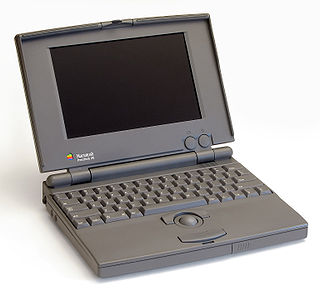
The PowerBook 100 is a portable subnotebook personal computer that was designed and manufactured by Sony for Apple Computer and introduced on October 21, 1991, at the COMDEX computer expo in Las Vegas, Nevada. Priced at US$2,300, the PowerBook 100 was the low-end model of the first three simultaneously released PowerBooks. Its CPU and overall speed closely resembled those of its predecessor, the Macintosh Portable. It had a Motorola 68000 16-megahertz (MHz) processor, 2-8 megabytes (MB) of memory, a 9-inch (23 cm) monochrome backlit liquid crystal display (LCD) with 640 × 400 pixel resolution, and the System 7.0.1 operating system. It did not have a built-in floppy disk drive and was noted for its unique compact design that placed a trackball pointing device in front of the keyboard for ease of use.
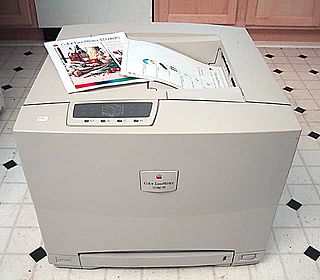
The Color LaserWriter is a line of PostScript four-color laser printers manufactured by Apple Computer, Inc. in the mid-nineties and compatible with PCs and its own Macintosh line of computers; by the use of an 10baseT Ethernet port it was also able to connect to large networks. Two models were released.

The Apple Communication Slot or Comm Slot is an internal expansion data interface (slot) found in Apple Macintosh computers from the early to mid-1990s. It was designed as an inexpensive way to add communication expansion cards like network adapters or modems to Macs and Power Macs.

The PowerBook 150 is a laptop personal computer created by Apple Computer, Inc. which was introduced on July 13, 1994, and released on July 18, 1994. It was the last member of the PowerBook 100 series to use the original case design, the most affordable of the series when introduced, priced between $1,450 and $1,600, and also the last consumer model.
The Macintosh Office was an effort by Apple Computer to design an office-wide computing environment consisting of Macintosh computers, a local area networking system, a file server, and a networked laser printer. Apple announced Macintosh Office in January 1985 with a poorly received sixty-second Super Bowl commercial dubbed Lemmings. In the end, the file server would never ship and the Office project would be cancelled. However, the AppleTalk networking system and LaserWriter printer would be hugely successful in launching the desktop publishing revolution.
